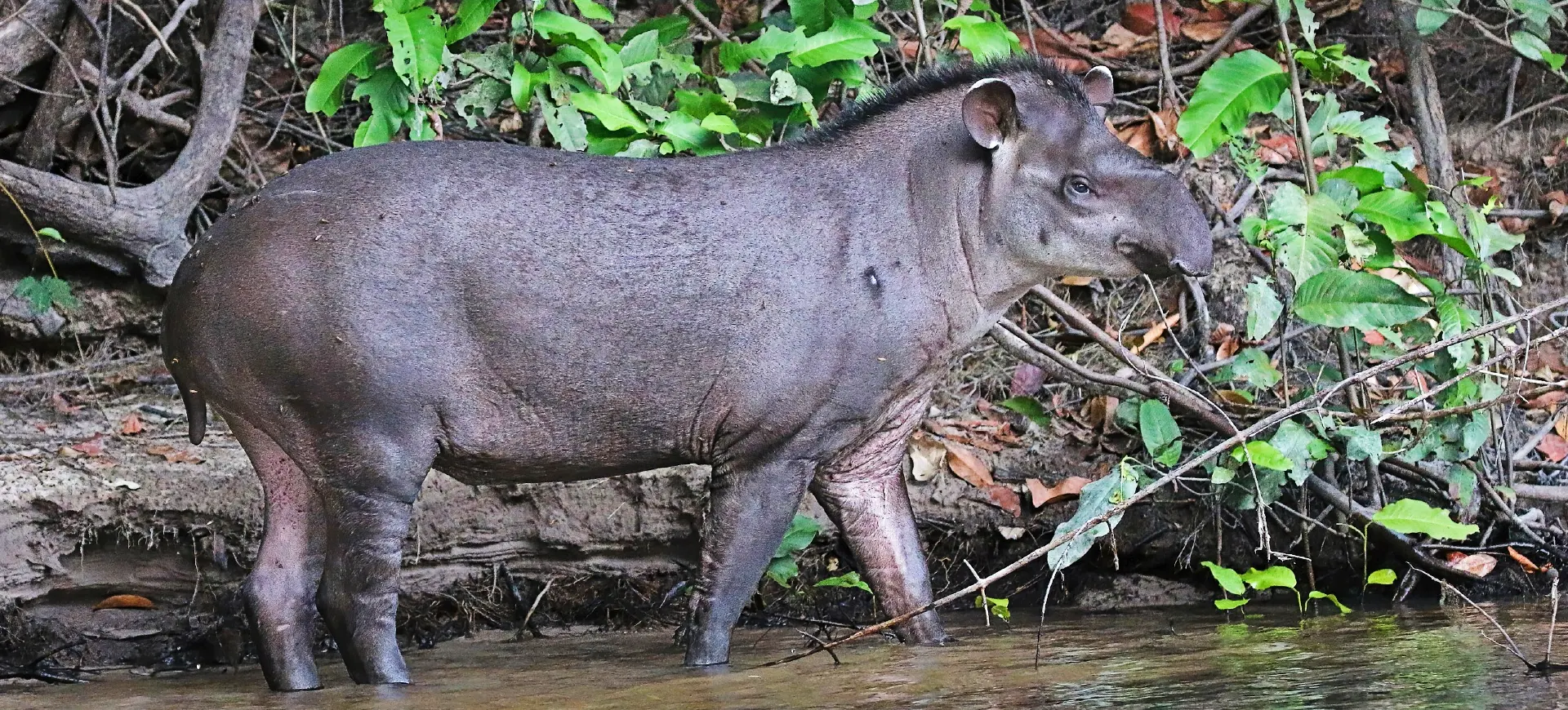Overview
The Malayan Tapir, also known as the Asian Tapir, is a large herbivorous mammal native to the rainforests of Southeast Asia. It is one of the five species of tapirs and is the only one native to Asia. The Malayan Tapir is easily recognizable by its distinctive black-and-white coloration, which serves as camouflage in its natural habitat.
The species is primarily nocturnal and spends most of its day resting in secluded spots. It is a solitary animal, with males and females coming together only for mating. The Malayan Tapir is an excellent swimmer and often seeks refuge in water to escape predators. It feeds on various plant materials, including leaves, twigs, and fruits.
Conservation efforts for the Malayan Tapir are ongoing, as the species is currently classified as Endangered. The primary threats to its survival include habitat loss due to deforestation and illegal hunting. Despite conservation initiatives, the population continues to decline, requiring urgent action to protect this unique species.
Taxonomy
Kingdom
Phylum
Class
Order
Family
Genus
Species
Type
Physical Description:
The Malayan Tapir is most notable for its unique black-and-white coloration. The front half of its body is black, while the rear half is white, creating a natural camouflage in the dappled light of its forest habitat. The species has a large, barrel-shaped body and a distinctive, elongated snout that is a prehensile organ for grasping food.
Adult Malayan Tapirs weigh between 550 and 800 pounds and can reach up to 8 feet. They have relatively short legs and small eyes. The ears are large and rounded, and the tail is short. Both males and females are similar in size and appearance, making it difficult to distinguish between them based on physical characteristics alone.

Lifespan: Wild: ~25 years || Captivity: ~35 years

Weight: Male & Female: 550–800 lbs (250–363 kg)

Length: Male & Female: 6–8 ft (183–244 cm)

Height: Male & Female: 36–42 in (90–107 cm)

Top Speed: 30 mph (48 km/h)
Characteristic:
Native Habitat:
The Malayan Tapir is native to the tropical rainforests of Southeast Asia, including parts of Thailand, Malaysia, Indonesia, and Myanmar. It prefers dense, wet forests near water sources, as it is an excellent swimmer and often seeks refuge in water. The species highly depends on undisturbed habitats, making it particularly vulnerable to deforestation and habitat loss.
Historically, the range of the Malayan Tapir was much more extensive, but human activities have significantly reduced its habitat. Current conservation efforts aim to protect remaining habitats and establish wildlife corridors to facilitate movement and genetic diversity.
Climate Zones:
Biomes:
WWF Biomes:
Biogeographical Realms:
Continents:
Diet:
Diet & Feeding Habits:
The Malayan Tapir is an herbivore that feeds on various plant materials. Its diet includes leaves, twigs, fruits, and aquatic plants when available. The species travels considerable distances searching for food, often covering several miles in a single night.
The prehensile snout of the Malayan Tapir is a highly specialized tool for grasping and manipulating food. It can extend and move in various directions, allowing the animal to reach vegetation that would otherwise be inaccessible. The species also has a complex digestive system that enables it to extract nutrients efficiently from its plant-based diet.
Mating Behavior:
Mating Description:
The Malayan Tapir is a solitary animal that comes together with a mate only during the breeding season. After a gestation period of approximately 13 months, the female gives birth to a single calf. The calf is born with a distinctive coat pattern of spots and stripes, which fades as it matures.
The mother primarily provides parental care and nurses the calf for several months. The young tapir becomes independent at about 18 months but may remain with the mother longer. Due to the extended period of parental care and the fact that females give birth to only one calf at a time, the species has a slow reproductive rate.
Reproduction Season:
Birth Type:
Pregnancy Duration:
Female Name:
Male Name:
Baby Name:
Social Structure Description:
The Malayan Tapir is a solitary animal, with males and females coming together only for mating. The species does not have a complex social structure and does not form herds. However, mother-calf pairs maintain a strong bond, and the young tapir may stay with the mother for an extended period before becoming independent.
While the Malayan Tapir is generally not territorial, it does mark its territory with scent markings. These markings serve as a form of communication between individuals, particularly during the breeding season. The species is known to be relatively docile but can be aggressive when threatened.
Groups:
Conservation Status:
Population Trend:
The Malayan Tapir is currently classified as Endangered, with fewer than 2,500 mature individuals estimated to exist in the wild. The primary threats to the species include habitat loss due to deforestation and illegal hunting for its meat and hide. Despite ongoing conservation efforts, the population continues to decline.
Conservation initiatives for the Malayan Tapir include habitat protection, anti-poaching measures, and public awareness campaigns. These efforts aim to halt the species’ decline and promote its recovery. However, the challenges are significant, and urgent action is needed to ensure the survival of this unique animal.
Population Threats:
The primary threats to the Malayan Tapir include habitat loss and fragmentation due to deforestation for agriculture and development. Illegal hunting for its meat and hide is another significant threat. The species is also at risk from road accidents and human-wildlife conflict, particularly in areas where its habitat overlaps with human settlements.
Additional threats include climate change and disease, which may further reduce its suitable habitats. The species’ slow reproductive rate makes it particularly vulnerable to these threats, as any loss of mature individuals significantly impacts the population.
Conservation Efforts:
Conservation efforts for the Malayan Tapir are focused on habitat protection and restoration. Anti-poaching measures are also in place, including increased patrolling and stricter enforcement of wildlife protection laws. Public awareness campaigns aim to educate local communities about the importance of the species and the threats it faces.
Collaborative efforts between governments, NGOs, and local communities are essential for conserving the Malayan Tapir. Research is ongoing to better understand the species’ ecology and behavior, which will inform future conservation strategies. Despite these efforts, the species remains at high risk, and more needs to be done to ensure its survival.
Additional Resources:
Fun Facts
- The Malayan Tapir is the only tapir species native to Asia.
- It has a unique black-and-white coloration that serves as natural camouflage.
- The species is an excellent swimmer and often seeks refuge in water.
- The Malayan Tapir has a prehensile snout that it uses to grasp food.
- It is primarily nocturnal and spends most of its day resting.
- The species has a slow reproductive rate, with females giving birth only one calf at a time.
- The Malayan Tapir is one of Southeast Asia’s most endangered large mammals.
- It has a complex digestive system that allows it to extract nutrients from a wide variety of plant materials.
- The species is known to travel considerable distances in search of food.
- Despite its large size, the Malayan Tapir is relatively agile and can run up to 30 mph.








